____________________________________________________________________________________________
2020-2021 年山东省泰安市肥城市高一英语上学期期中试卷
及答案
第一部分 听力(共两节,满分 30 分)
第一节 (共 5 小题;每小题 1.5 分,满分 7.5 分)
听下面 5 段对话。每段对话后有一个小题,从题中所给的 A、B、C 三个选项中选出最佳
选项,并标在试卷的相应位置。听完每段对话后,你都有 10 秒钟的时间来回答有关小题和阅
读下一小题。每段对话仅读一遍。
1. Where is probably Sue now?
A. At home.
B. At Bill’s home.
C.
At
the
office.
2. What does the woman want to do?
A. Quit smoking.
B. Change a seat.
C. Buy a cake.
3. What did the man do last weekend?
A. He took a trip.
B. He watched a game.
C. He played basketball.
4. What does the man need now?
A. Ice cream.
B. Milk.
C. Water.
5. Where does the woman want to go?
A. The bus station.
B. The train station.
C.
The
police
station.
第二节(共 15 小题;每小题 1.5 分,满分 22.5 分)
听下面 5 段对话或独白。每段对话或独白后有几个小题,从题中所给的 A、B、C 三个选
项中选出最佳选项,并标在试卷的相应位置。听每段对话或独白前,你将有时间阅读各个小
题,每小题 5 秒钟;听完后,各小题将给出 5 秒钟的作答时间。每段对话或独白读两遍。
听下面一段对话,回答第 6 和第 7 两个小题。
6. What does Jack have to do at 10:00 am?
A. Attend a lecture.
B. Catch a bus.
C. Repair his bike.
�
____________________________________________________________________________________________
7. How does the boy usually go to school?
A. By bus.
B. By bike.
C. By car.
听下面一段对话,回答第 8 和第 9 两个小题。
8. Whom is the party for?
A. Lisa.
B. Jane.
C. Ted.
9. What does the man advise the woman to do?
A. Play some games.
B. Bring Jane along.
C. Watch a video.
听下面一段对话,回答第 10 至第 12 三个小题。
10. What does the woman think of the bedroom?
A. Bright.
B. New.
C. Small.
11. What does the woman like best?
A. The kitchen.
B. The view.
C. The living room.
12. What will the speakers do most probably?
A. Have the shower repaired.
B. Buy some furniture.
C. Keep searching.
听下面一段对话,回答第 13 至第 16 四个小题。
13. What is the possible relationship between the speakers?
A. Teacher and student.
B. Classmates.
C. Colleagues.
14. Where does the conversation probably take place?
A. In the classroom.
B. Over the phone.
C. At the woman ’ s
home.
15. Why does Tom feel stressed out?
A. He can’t speak English well.
B. He has known the exam result.
C. He didn’t do well in the English exam.
16. What is the woman’s suggestion?
A. Correcting the mistakes now.
B. Paying more attention next time.
C. Communicating with parents.
听下面一段独白,回答第 17 至第 20 四个小题。
�
____________________________________________________________________________________________
17. How many foreign students are visiting in the speaker’s school now?
A. About 13.
B. About 20.
C. Over 30.
18. Why does the school organize the music week?
A. To attract more foreign students.
B. To exchange ideas about culture.
C. To help foreign students enjoy their time.
19. When should students sign up for the activities?
A. Before September 15th.
B. In the last week of September.
C. In the first week of December.
20. Where will the music week be held?
A. In the library.
B. In the garden.
C.
On
the
playground.
第二部分 阅读 (共两节,满分 50 分)
第一节 (共 15 小题;每小题 2.5 分,满分 37.5 分)
阅读下列短文,从每题所给的 A、B、C、D 四个选项中选出最佳选项。
A
Country Walks
Hope village
A leisurely (悠闲的) way to spend an hour or two is by visiting the busy village
of Hope with its lovely country gardens. A gentle walk towards the hills will soon
bring you to excellent views.
Country Park
The Lime House here attracts thousands of visitors, but this is a pleasant walk
away from the crowds, through parkland, woods and up onto the hills. Popular with
bird-watchers. Allow three hours. The house was built in 1570.
Cornford
This is an easy walk through a little-known valley. See the 200-year-old
buildings from the cloth-making industry which now stand empty.
Devonshire Park
�
____________________________________________________________________________________________
Allow at least half a day, or make it a full day by visiting the adventure
playground and farmyard. Stop at the cafe (open all day) or enjoy the fantastic
gardens. Guided walks are available (可获得的) for small groups.
Howden lake
This two-hour walk attracts thousands of visitors. Children can go sailing on
the lake with trainers.
Stanton
This walk is certainly for very fit walkers only—the paths get very slippery
(滑的) after rain. Allow six hours and start early! You’re unlikely to meet another
person all day. Be sure to pack food—you’ll be up on the hilltops all day.
Strines
You need to be used to walking to successfully complete this seven-hour walk
through the wildest scenery in the area. Follow a little-known footpath to the
highest point for miles.
Langsett
This is an exciting walk along easy paths, which are crowded at weekend. And
it s a popular place for family picnics. Guided walks start from the near village
(10am Sundays) and visit 800-year-old woodland.
21. What is special about Country Park?
A. It is in a little-known valley.
B. It includes a house for making cloth.
C. It should be booked ahead of time.
D. It enjoys popularity among bird-watchers.
22. What do Devonshire Park and Langsett have in common?
A. They offer guided walks.
B. They are open for half a day.
C. They are for small groups.
D. They have adventure playgrounds.
23. Which of the following is only suitable for very strong walkers?
A. Cornford.
B. Stanton.
C. Hope Village.
D. Howden Lake.
�
____________________________________________________________________________________________
B
Like any new ninth-grader on the first day of school, Joemar Class had
ninth-grader feeling. He’s not used to school in Hartford. He’s used to going to
school in his home town of Florida, used to seeing his friends, used to having class
in Spanish.
“Nervioso,” he said in Spanish.
We first met Joemar in mid-October in the San Juan Airport. His father, Guillermo
Class, had sold his car to buy plane tickets to get his kids and fly them up from
Puerto Rico. The island was almost destroyed (毁坏) by the deadly storm—Hurricane
Maria.
Now, they are settling into their new home in Hartford’s South End. A week later,
and, using his wife’s car, Class drove 16-year-old Joemar to his first day at Bulkeley
High School. After a short ride, he got out in front of his new school. Inside, he
met Gretchen Levitz—the school’s program director.
“I see you have new uniform (校服),” Levitz said. “You look great. Are you
ready for a good first day?”
Then he met couple of teachers.
“Hello,” they each said in Spanish. They asked where he’s from, and told him
they were happy to see him. Then Levitz took him on a quick tour of the school before
classes began—to her office, the school store, the library, and the dining hall.
A total of 19 languages are spoken in Bulkeley High School. “We have so many
new students coming here from other countries every single day,” Levitz said. “So
it’s not like he’s the only one who has that feeling.”
“You could tell he’s little worried,” Guillermo said as we left. “But, at
the same time, he’s looking forward to it.”
24. What does the underlined word “Nervioso” in paragraph 2 probably mean?
A. Frightened.
B. Excited.
C. Relaxed.
D. Nervous.
25. Why did Joemar leave Florida?
A. His old school closed down.
B. His town was hit by a terrible storm.
�
____________________________________________________________________________________________
C. He wanted to see his mother.
D. He expected to have a new life.
26. What did Joemar do before he walked into his new classroom?
A. He had a short look around his new school.
B. He learned some simple Spanish words.
C. He said hello to some of his classmates.
D. He had a long talk with his father.
27. What can we learn about Bulkeley High School?
A. It has no library.
B. It plans to open Spanish
classes.
C. It is an international school.
D. It requires all students
to wear uniforms.
Teenagers have their own TV channels, websites and magazines. So what about
C
books?
Last year one publisher, Martins, started publishing a series called Waves. We
spoke to the director Julia Smith. She explained, “Teenage fiction (小说) has been
published since the 1970s but publishers have never been very successful in getting
teenagers to buy and read books. Now they’re realizing that teenagers are just older
children, but are not adults either. They are often not interested in adult fiction.
For this series we are looking for new writers who write especially for teenagers.”
Athene Gorr’s novel was published in the series last year and is selling well.
Its title is The Purple Ring. She says, “The important thing is to encourage
teenagers to pick up your book. I’m a new writer. Although I’ve got an unusual
name which people might remember, nobody knows it yet! But my book has a fantastic
cover which makes people want to look inside. Then they realize what an excellent
story it is!”
And what do teenagers themselves think about the series? We talked to Sophie
Clarke, aged 15. She said, “I’ve read a few books in the Waves series. They say
�
____________________________________________________________________________________________
they are for 14-19 year olds and I agree with that. We’re not interested in the
same things as people in their twenties and thirties. I like them and I think they
look really good too. The only thing is that because bookshops put them in the
children section, lots of teenagers won’t find them so they may not do very well.
And it’s a shame there’s no such series as I think lots of teenagers, especially
boys, might buy.”
28. What can we infer from paragraph 2?
A. The Waves series are suitable for adults.
B. Teenagers should be encouraged to read.
C. Teenagers are more interested in reading nowadays.
D. It is necessary to publish books aimed at teenagers.
29. What makes The Purple Ring catch people’s eye?
A. Its cover.
B. Its price.
C. Its writer.
D. Its title.
30. What do we know about the Waves series?
A. They are about real facts.
B. They are popular with teenage boys.
C. They are wrongly placed in the children section.
D. They have attractive covers.
31. What does the author intend to do with the text?
A. To compare different series of teenage fiction.
B. To encourage more writers to create fictions for teenagers.
C. To give information about a new series of books.
D. To explain why teenage fiction is easier to write than adult fiction.
D
When you visit Kinderdijk, one of the most visited villages in the Netherlands,
you step right into the middle of Dutch history.
Kinderdijk lies in the Alblasserwaard, where the Lek and Noord rivers meet
together. Much of the village is near or even below sea level. Although there are
canals and dykes (堤坝), the lowlands of the village are still at risk of flooding
�
____________________________________________________________________________________________
(洪灾). Among the most deadly floods was Saint Elisabeth’s flood in 1421, which
killed thousands after the dykes broke in several places. To deal with this kind
of problem, the Kinderdijk windmills (风车) were built around 1740 to move water
from the lower areas to higher ground and into the river.
Nineteen of the 20 Kinderdijk windmills remain and were named a UNESCO World
Heritage (遗产) Site in 1997. Of the 19 windmills, 16 still have millers who live
inside and control the huge sails (翼板) in the wind. These windmills continue to
help manage the Netherlands ongoing fight to stay above water.
For tourists, boat tours are offered along the canals and walkways lead from
the visitor center to the windmills. Two windmills serve as museums, filled with
old millers’ items and photos. You can climb up inside to see how the windmills
work. The windmills also are working, so be prepared to feel the whole building shake
when the sails turn in the wind.
Each year, about 500,000 people visit the Kinderdijk windmills and the buildings
have become a must-see on any trip to the Netherlands. There are some windmills north
of Amsterdam that “were built for tourists, but we’re a historical site where
tourists come, so it’s the other way around,”says Kinderdijk communications manager
Peter Paul Klapwijk. “Tourism is a good way to support our site.”
32. Why were the Kinderdijk windmills built around 1740?
A. To protect dykes.
B. To produce clean water.
C. To prevent floods.
D. To keep the sea level from
rising.
33. What can we learn about Kinderdijk windmills?
A. Most of them are working as before.
B. Most of them have become museums.
C. Several of them have been sold to millers.
D. Several of them were destroyed long ago.
34. How does Peter Paul Klapwijk feel about so many tourists visiting the windmills?
A. Fearful.
B. Worried.
C. Excited.
D.
Surprised.
�
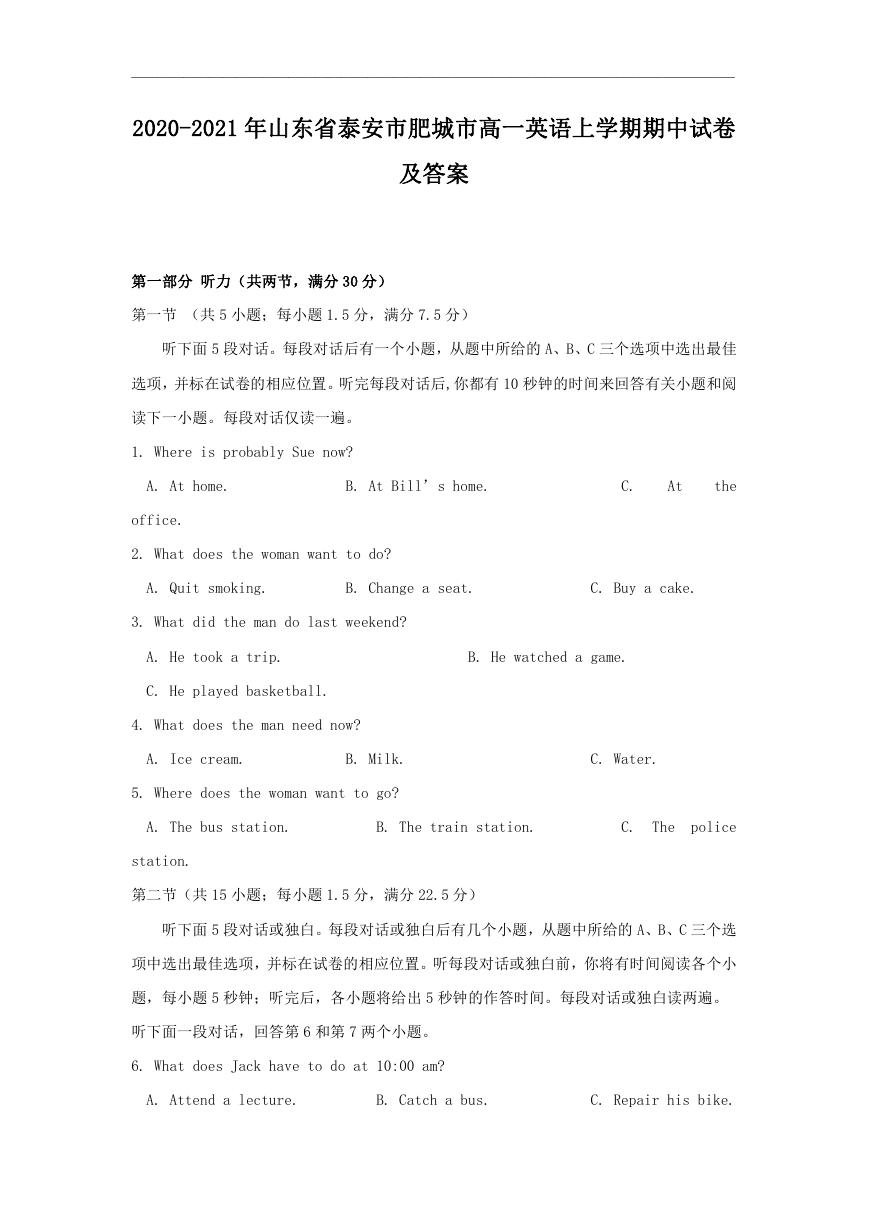
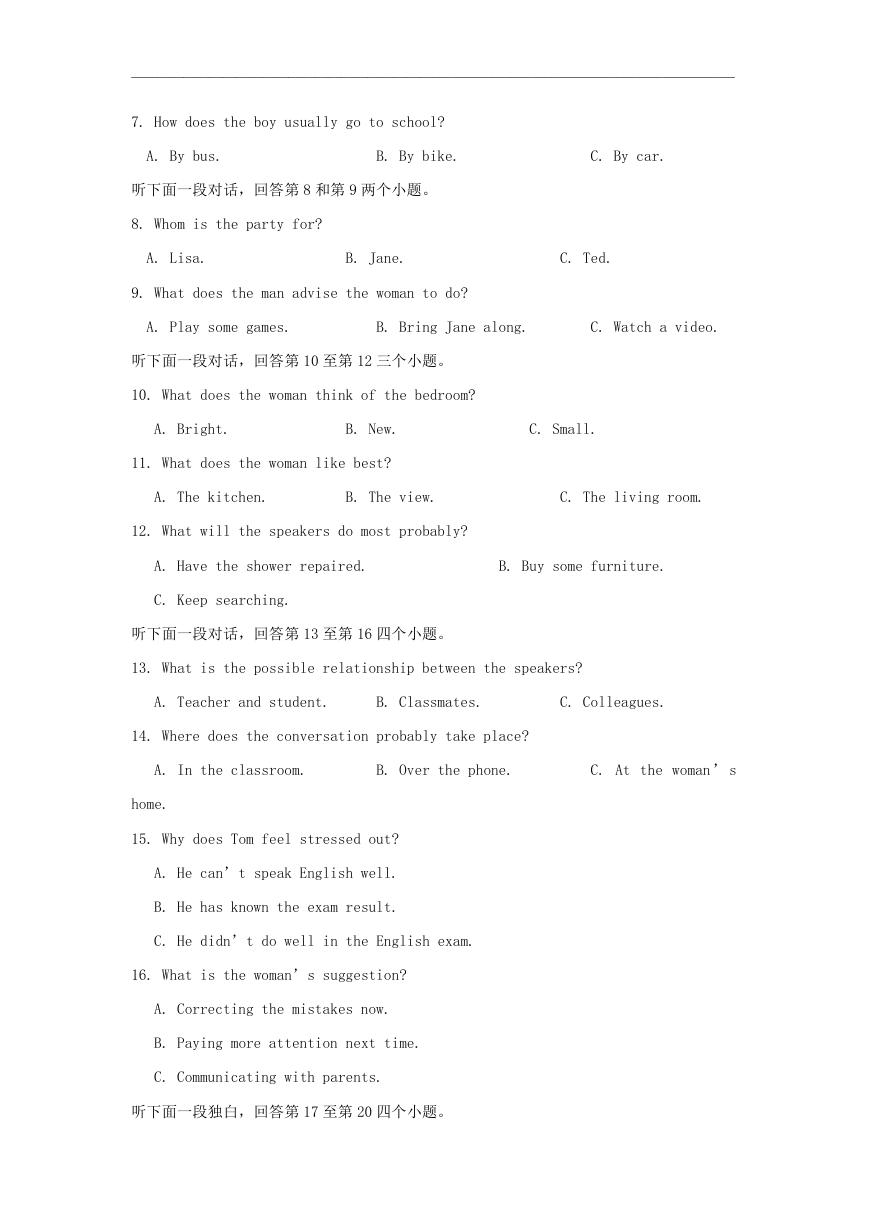

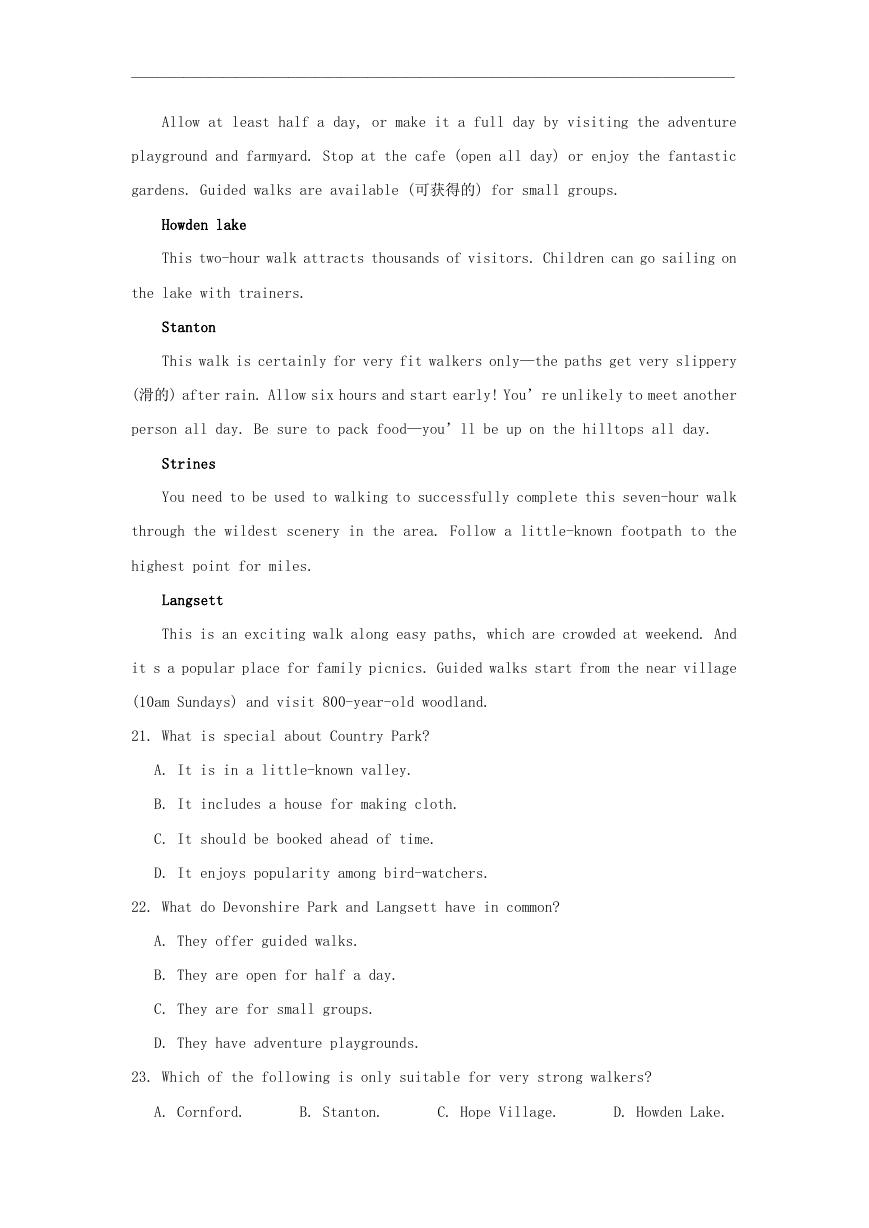
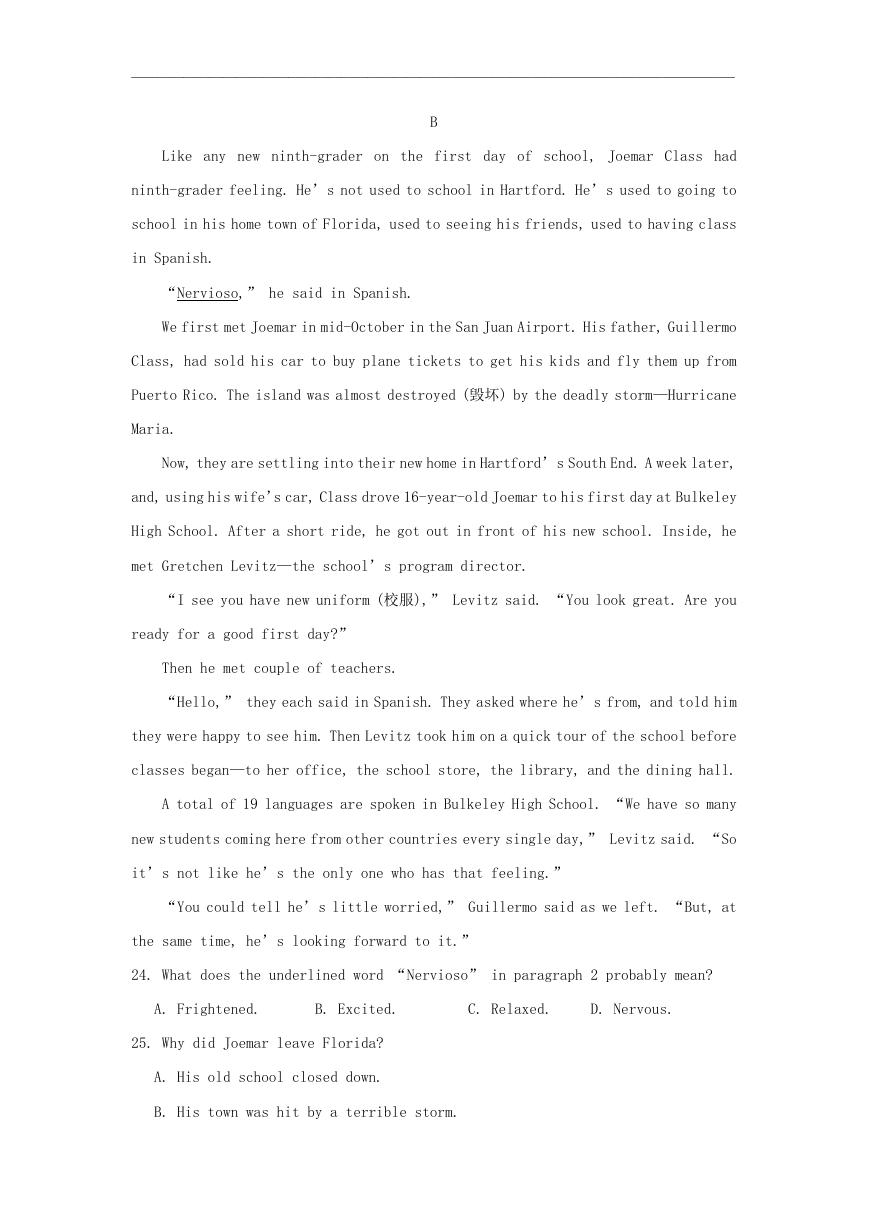
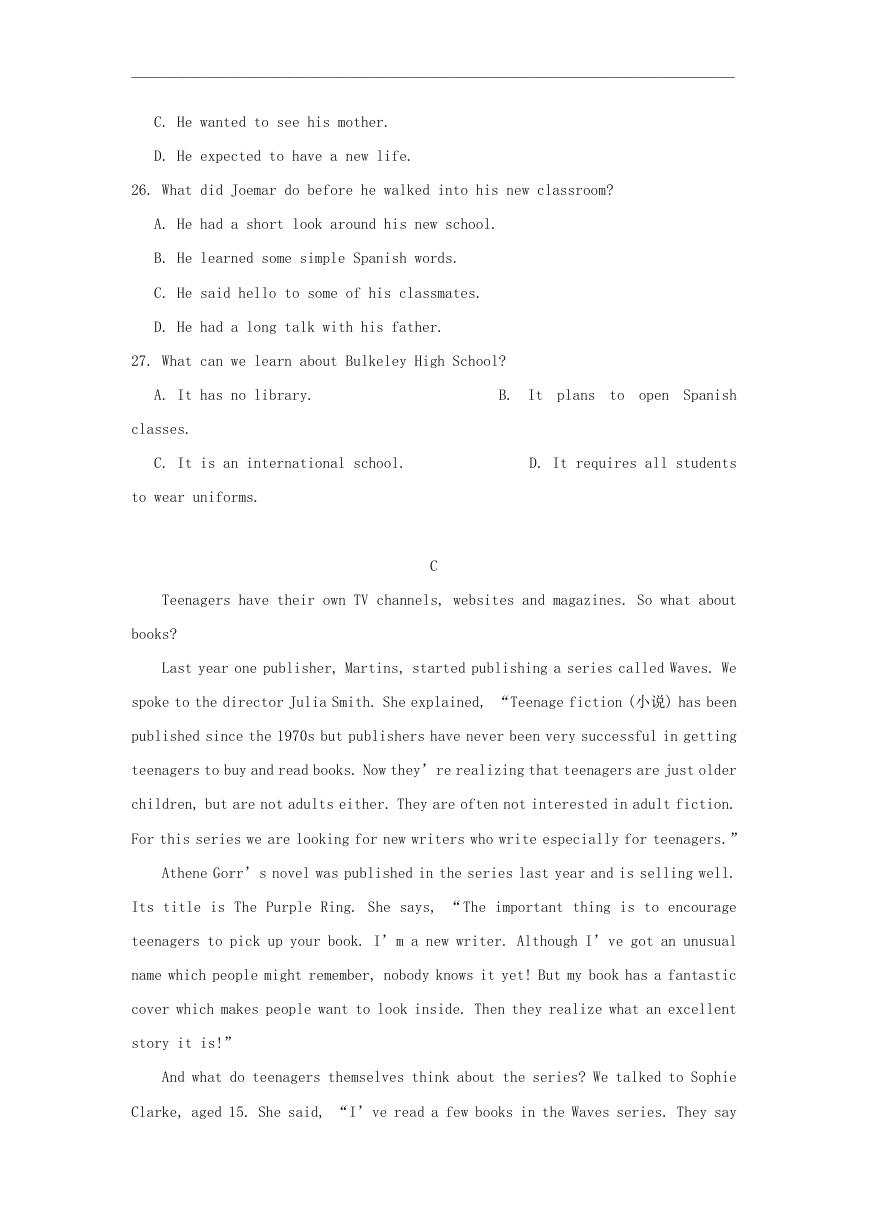
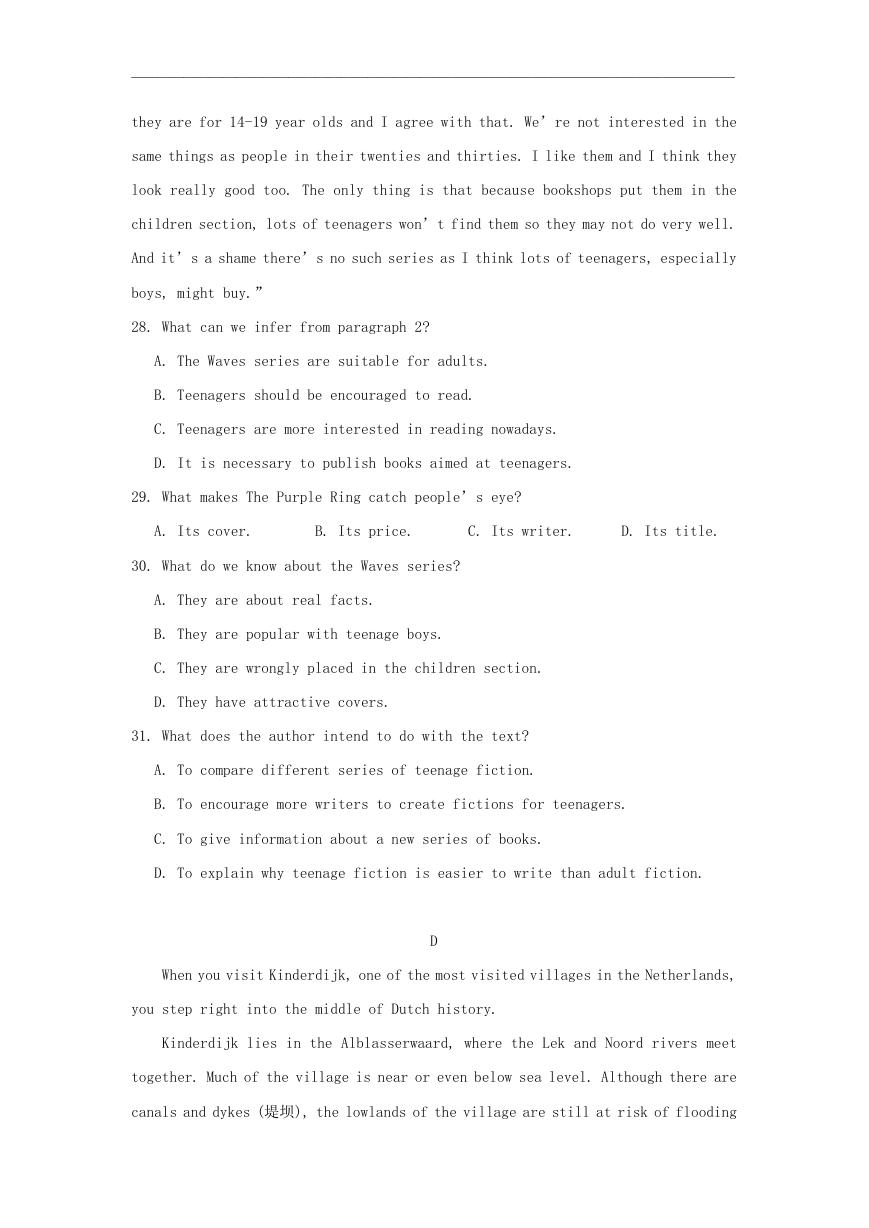
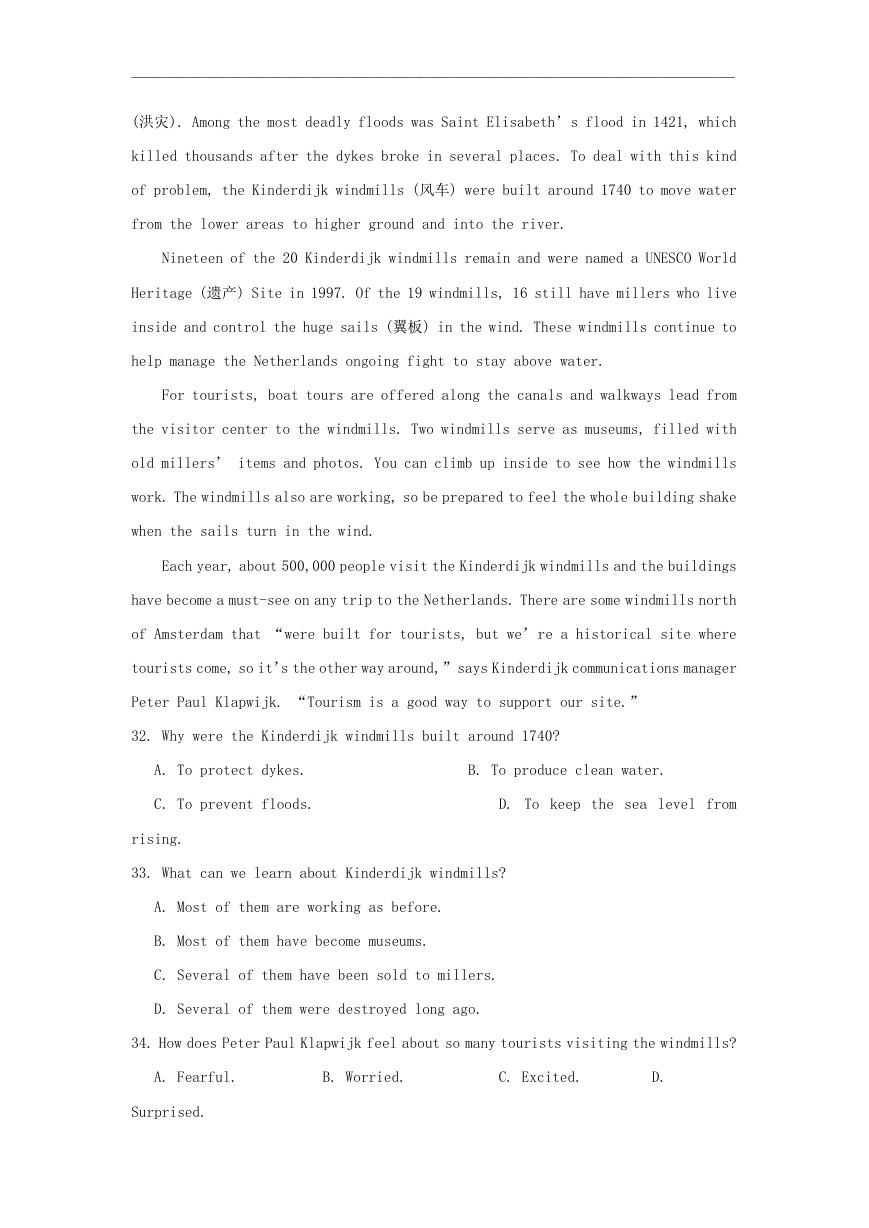








 2023年江西萍乡中考道德与法治真题及答案.doc
2023年江西萍乡中考道德与法治真题及答案.doc 2012年重庆南川中考生物真题及答案.doc
2012年重庆南川中考生物真题及答案.doc 2013年江西师范大学地理学综合及文艺理论基础考研真题.doc
2013年江西师范大学地理学综合及文艺理论基础考研真题.doc 2020年四川甘孜小升初语文真题及答案I卷.doc
2020年四川甘孜小升初语文真题及答案I卷.doc 2020年注册岩土工程师专业基础考试真题及答案.doc
2020年注册岩土工程师专业基础考试真题及答案.doc 2023-2024学年福建省厦门市九年级上学期数学月考试题及答案.doc
2023-2024学年福建省厦门市九年级上学期数学月考试题及答案.doc 2021-2022学年辽宁省沈阳市大东区九年级上学期语文期末试题及答案.doc
2021-2022学年辽宁省沈阳市大东区九年级上学期语文期末试题及答案.doc 2022-2023学年北京东城区初三第一学期物理期末试卷及答案.doc
2022-2023学年北京东城区初三第一学期物理期末试卷及答案.doc 2018上半年江西教师资格初中地理学科知识与教学能力真题及答案.doc
2018上半年江西教师资格初中地理学科知识与教学能力真题及答案.doc 2012年河北国家公务员申论考试真题及答案-省级.doc
2012年河北国家公务员申论考试真题及答案-省级.doc 2020-2021学年江苏省扬州市江都区邵樊片九年级上学期数学第一次质量检测试题及答案.doc
2020-2021学年江苏省扬州市江都区邵樊片九年级上学期数学第一次质量检测试题及答案.doc 2022下半年黑龙江教师资格证中学综合素质真题及答案.doc
2022下半年黑龙江教师资格证中学综合素质真题及答案.doc